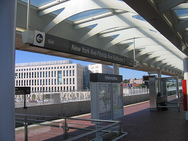WMATA considering policies for shorter station names

Photo by tracktwentynine on Flickr.
Metro might take a harder line against sprawling station names like U Street/African-Amer Civil War Memorial/Cardozo in the future, under a policy WMATA’s Board will discuss on Thursday.
The problems with Metro’s station name sprawl are not new. But with the Silver Line and “Yellow and Orange Line Service Increase” coming, Metro will have to redo maps and station signage anyway, opening the door to renaming more stations at the same time without much extra cost.
Fairfax has suggested some widely-panned names for its new stations, which repeat the same words multiple times and lack character. The NoMA BID is proposing renaming New York Ave-Florida Ave-Gallaudet U to the shorter NoMA-Gallaudet U, while the Capitol Riverfront BID wants to add its neighborhood moniker to the Navy Yard station. There may be more proposals as well.
The WMATA Board has final approval over all of these changes. Should they accept the Fairfax names or push for something more distinctive? Should they allow the NoMA and Capitol Riverfront changes or just ones that shorten names? Should Metro go farther and actually push to change those station names which are egregiously long?
Metro is not proposing renaming any stations (yet). Instead, the staff are bringing a general policy before the Board. If the Board accepts the policy, then it would guide specific station decisions to come.
Brief station names are important for a variety of reasons, including ease of navigation in the system. Extremely long station names can also make communication difficult, especially to non-English speakers.
The current policy, which Metro has not entirely adhered to over the years, lays out the following conditions:
- Proposed names come to the Board from the jurisdictions.
- Names should identify the station by geographical features or centers of activity.
- The names should be distinctive and evoke imagery in the mind of the patron.
- Station names should be no longer than 19 characters (including spaces).
- Transfer station names should be no longer than 13 characters.
- The jurisdiction requesting the renaming must pay the cost.
New rules proposed by staff include:
- Station renamings must also involve customer testing and feedback.
- Sale of station naming rights to corporations would be prohibited.
While these changes are welcome, they won’t mean very much if the jurisdictions and the Board don’t abide by the policy. In the past, the Board has gone along with jurisdictional requests that didn’t conform. Rejecting overly long or overly nondescript station names will require Board members to vote down a proposal by one of their colleagues for a station in that member’s jurisdiction.
Alternatively, the Board could allow for additional parts of station names to be subtitles. Most people refer to U St/African-Amer Civil War Memorial/Cardozo as simply “U Street.” If DC weren’t willing to completely shorten the name to that or its pre-1999 name of “U Street/Cardozo,” then U Street could be the main name and the rest could become a subtitle. In fact, several of the entries in our map contest took this approach.
A stricter policy could include guidelines like these:
- Station names may not exceed 19 characters in length.
- Transfer station names may not exceed 13 characters in length.
- When circumstances dictate, the Board may grant a subtitle name to a station beyond the character limit.
- Station renamings should only occur when significant rider benefit would be gained from a renaming.
- Station names should derive their names from a specific, unique geography or center of activity.
- Station names should be distinctive and evoke imagery in the mind of the patron.
- If a landmark is used in a name, it must be within ¼ mile of the station.
- The number of geographies or centers of activity is limited to a maximum of 2.
- Use of abbreviations should be permitted only for street types, e.g. “Ave.”
- Station name elements should be separated with a forward slash (not a dash).
- Rider feedback should be required before a station renaming is approved.
- The sale of station naming rights is not permitted.
Staff plan to talk with riders about the station naming policy before finalizing it, hopefully in July. Jurisdictions will then be able to propose name changes by September for the Board to approve in October.
Name changes can still happen in the future, but there’s a substantial cost to replace maps and signs. Since Metro is already planning replace all of the maps and signs in 2012, this is one of the best opportunities in a long time to make name changes, including shortening names.
